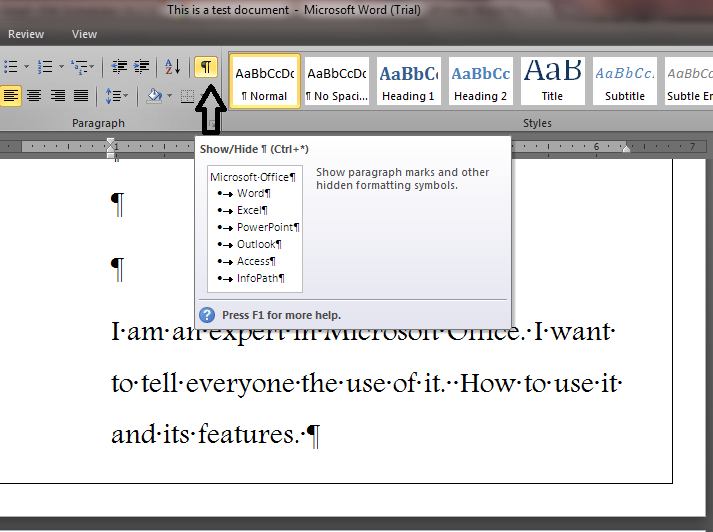Paragraph Marks On Microsoft Word For Mac 2011
Sometimes you want the placement of your text on each page of your Word for Mac 2011 document to be aesthetically pleasing. Consider how important it is to have a poem or a quotation look just right to create the desired ambience on the page. In these situations, you might need to adjust values for line spacing and paragraph spacing. I have a 2008 MS Word for Mac and for some reason I do not understand, suddenly I have those weird paragraph marks appearing on every line. In previous versions of Word, I think there was somewhere in the visible tool bar an image of that actual 'backwards P' paragraph symbol that one could uncheck to hide. I have nothing like that on this version.
Word 2011 for Mac lets you create, edit, and add new dictionaries to its collection of dictionaries. Perhaps your discipline, science, or profession uses a lot of specialized terms not found in the Word default dictionary, or maybe you need to add a dictionary for a language not supplied with Office 2011 for Mac.
Oct 29, 2012 A brief lesson on how to perform the necessary tasks in Microsoft Word 2011 (Mac OS X) in order to achieve simple MLA formatting for academic essays. Dec 24, 2012 I have a 2008 MS Word for Mac and for some reason I do not understand, suddenly I have those weird paragraph marks appearing on every line. In previous versions of Word, I think there was somewhere in the visible tool bar an image of that actual 'backwards P' paragraph symbol that one could uncheck to hide. I have nothing like that on this version. May 26, 2015 If you've noticed dots appearing where your spaces should be, and funny backwards-looking 'P's at the end of every paragraph then you have the formatting marks set to 'show'. In this video I. May 19, 2019 For the simple steps to easily remove hard returns or paragraph marks from a text file in Microsoft Word continue reading or watch my video: Displaying Paragraph Marks in a Document The first thing you want to do is to get more information. Word 2011 has significantly improved collaboration tools, making it obvious that Microsoft now considers Word for Mac, and thereby the Mac itself, to be an enterprise-level work tool.
A dictionary is simply a list of words with a paragraph mark after each word (created by pressing Return or Enter) in which the words are saved as a file with a .dic extension. Dictionary files aren’t different for Mac or Windows, but beginning with Word 2011, Word on the Mac may demand dictionaries that were saved a special way in order to support UniCode fonts.
You can find custom dictionaries and foreign language dictionaries on the Internet by searching for them, and many are free.
To add a custom dictionary file, take these steps:
Choose Word→Preferences from the menu bar.
In the Authoring and Proofing Tools section, choose Spelling and Grammar.
In the Spelling section, click the Dictionaries button.
Click the Add Button.
Navigate to the .dic dictionary file and select it.
Microsoft outlook for mac os high sierra 10.13.3. If the .dic file you want to use is grayed out, switch the Enable pop-up menu to All Files.
Click Open.
Your custom dictionary appears with a check box that’s selected in the Custom Dictionaries dialog.
Click OK to close the Custom Dictionaries dialog and then click OK to close the Spelling and Grammar preferences pane.
Your new dictionary is now available to Word, Excel, and PowerPoint. Outlook uses the Mac OS X dictionary.
Editing a custom dictionary in Word 2011 for Mac

Because dictionaries are simply text files, you can open them in Word, add and remove words, and save them again. If you ever accidentally add a misspelling to a custom dictionary or if you want to add or remove words, follow these steps:
In Word, choose File→Open.
Select All Files from the Enable pop-up menu.
Choose the .dic file you want to use and click Open.
Click the Show button on Word’s Standard toolbar to toggle on the ability to see paragraph marks if they aren’t showing already.
Add or remove words from the list.
Click the Save button on Word’s Standard toolbar to save your changes; then click the Close button to close the document.
Making a new custom dictionary in Word 2011 for Mac
If you found a list of words, or you don’t mind typing your own list, you can start from scratch with an empty dictionary, and then add your list to it using the steps to edit a dictionary from the previous section. Here’s how to make a new, blank custom dictionary:
Microsoft Office For Mac
Choose Word→Preferences from the menu bar.
In the Authoring and Proofing Tools section, choose Spelling and Grammar.
In the Spelling section, click the Dictionaries button.
Click the New Button.
Give your dictionary a name and then save it.
Click OK to close the Custom Dictionaries dialog and then click OK to close the Spelling and Grammar preferences pane.
Your new, empty dictionary is now available to all Office applications.